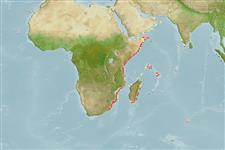Olocefali (chimere) (chimaeras) >
Chimaeriformes (Chimaeras) >
Chimaeridae (Shortnose chimaeras or ratfishes)
Etymology: Hydrolagus: hydro-, combining form of hydor (Gr.), water; lagos (Gr.), hare, i.e., “water rabbit,” probably referring to three pairs of tooth plates, which tend to protrude from the mouth like a rabbit’s incisors. (See ETYFish); africanus: -anus (L.), belonging to: Africa, described from deep water off the KwaZulu-Natal South Coast of South Africa. (See ETYFish).
Environment: milieu / climate zone / depth range / distribution range
Ecologia
marino batidemersale; distribuzione batimetrica 421 - 750 m (Ref. 3181). Deep-water
Western Indian Ocean: off Kenya, Mozambique and Natal, South Africa.
Size / Peso / Age
Maturity: Lm ? range ? - ? cm
Max length : 67.0 cm TL maschio/sesso non determinato; (Ref. 3181)
Short description
Chiavi di identificazione | Morfologia | Morfometria
Spine dorsali (totale) : 1; Spine anali: 0; Raggi anali molli: 0. A shortnose chimaera with the dorsal fin spine longer than the head; 2nd dorsal fin with distinct concavity in the middle (Ref. 5578).
Feeds on ophiuroids (Ref. 27637). Oviparous (Ref. 205). Eggs are encased in horny shells (Ref. 205).
Life cycle and mating behavior
Maturities | Riproduzione | Spawnings | Egg(s) | Fecundities | Larve
Compagno, L.J.V., 1986. Chimaeridae. p. 144-145. In M.M. Smith and P.C. Heemstra (eds.) Smiths' sea fishes. Springer-Verlag, Berlin. (Ref. 3181)
IUCN Red List Status (Ref. 130435)
Human uses
Pesca: di nessun interesse
Strumenti
Special reports
Download XML
Fonti Internet
Estimates based on models
Preferred temperature (Ref.
123201): 8.9 - 11.4, mean 9.7 °C (based on 16 cells).
Phylogenetic diversity index (Ref.
82804): PD
50 = 0.5000 [Uniqueness, from 0.5 = low to 2.0 = high].
Bayesian length-weight: a=0.00282 (0.00118 - 0.00673), b=3.10 (2.89 - 3.31), in cm total length, based on LWR estimates for this (Sub)family-body shape (Ref.
93245).
Trophic level (Ref.
69278): 4.1 ±0.60 se; based on food items.
Resilienza (Ref.
120179): Basso, tempo minimo di raddoppiamento della popolazione 4.5 - 14 anni (Assuming Fec <100).
Fishing Vulnerability (Ref.
59153): Moderate to high vulnerability (47 of 100).
